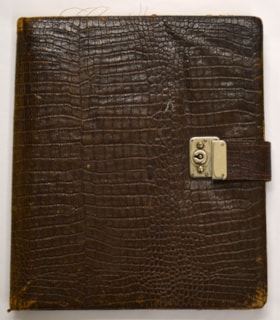Narrow Results By
Autograph Book
https://www.cjhn.ca/link/cjhn47991
- Collection
- Montreal Holocaust Museum
- Description Level
- Item
- Material Type
- textual record
- Physical Description
- Autograph Book : leather work, handwritten, photography, graphic arts : brown, beige, multi-coloured ; Ht: 20,2 cm x W: 17,4 cm
- Date
- 1938-July 9, 1943
- Collection
- Montreal Holocaust Museum
- Description Level
- Item
- Material Type
- textual record
- Physical Description
- Autograph Book : leather work, handwritten, photography, graphic arts : brown, beige, multi-coloured ; Ht: 20,2 cm x W: 17,4 cm
- Other Title Information
- Documentary Artifact
- Date
- 1938-July 9, 1943
- Physical Condition
- Good
- Language
- French
- Yiddish
- German
- Italian
- Spanish
- Notes
- 110 pages. Hardcover, cardboard bound with glue and fabric. Cover is brown leather with a crocodile-skin pattern and a silver key-clasp; the edges and corners are rounded and the page edges are gilded; the binding fabric is red. Inside covers have a printed abstract pattern with multi-coloured smears of paint along the verticle axis. Interior pages are beige; primarily used as an autograph book. Autographs are found throughout in blue, black, green and purple inks, or in pencil. Drawings have been done in ink or pencil. One b&w photograph is attached to its own page: shows a woman in a dress, crouching outside on the ground, on a matt, with one arm extended as if to crawl, there is surrounding greenery with a mountain in the background. 2 pages of pressed flowers are found in the book: the first has only a 4-leaf clover; the second is filled with wildflowers, with stalks of wheat in the center. Many pages of the book are still blank. Book belonged to German Jewish woman named Hanna Landé. Narrative: Autographs, well-wishes and drawings to Hanna Landé. Written before and during her internment in Gurs internment camp. Earliest autograph dates from 1938. Hanna was in Paris in 1939, and in Villerbon in Dec. 1939. From July 1940 to June 1943, she was interned at Gurs. Gurs was an internment camp in south-western France along the Spanish border; it was originally used by the French to intern prisoners from the Spanish Civil War. On May 21, 1940, the Vichy government incarcerated German and other Axis citizens, as well as sympathizers at the camp, adding them to the existing Spanish population. When the armistice was signed with Germany, the Vichy government liberated the prisoners and burned the records (August to October 1940). The Nazis took over the camp in October 1940, filling it with Jews from other camps, Spaniards, and other "undesirables". There were numerous escapes from the camp (755 recorded) and it was only moderately secure, without the gun towers and a barbed wire fence only a few feet high. As of August 6, 1942, the camp's Jews were deported, usually to Drancy and from there on to Auschwitz.
- Accession No.
- 2008.01.01
- Name Access
- Wendt, Wulfram
- Places
- France, Europe
- Archival / Genealogical
- Archival Descriptions
- Repository
- Montreal Holocaust Museum
Images
{{ server.message }}


